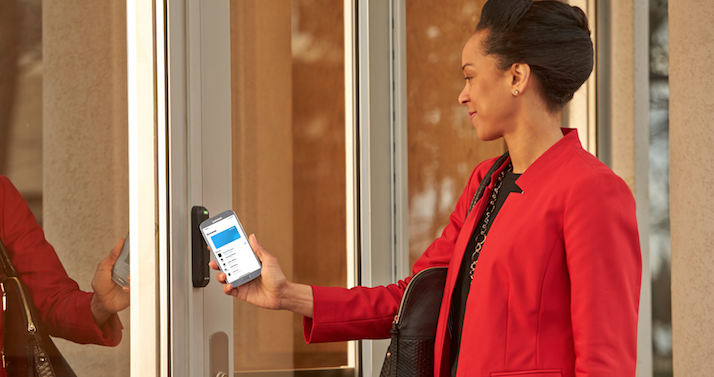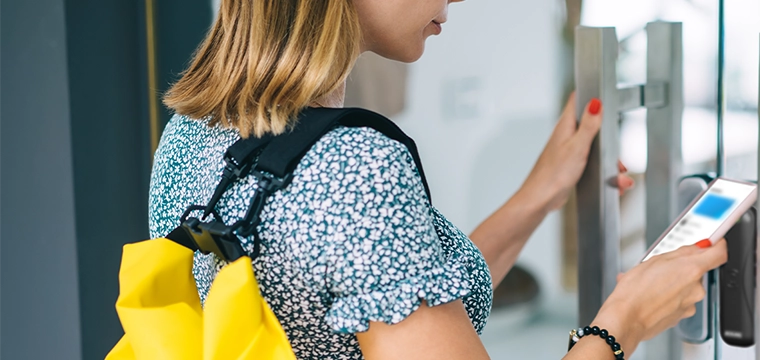
 By Jeff Koziol, Allegion’s business development manager of campus software partners
By Jeff Koziol, Allegion’s business development manager of campus software partners
Credential technology has come a long way since the first electronic card access system was developed in 1968. For decades, universities have used some form of campus card. Yet many campuses have made few changes to the legacy technology they adopted years ago.
While many understand the risks of outdated technology, they haven’t made the change to something more secure, like smart cards or mobile student IDs. And those who had plans in place likely saw them shattered when the pandemic struck last year, forcing universities to pivot their 2020 initiatives.
Ironically, the pandemic uncovered the benefits of a contactless campus, leaving many to revisit the need to invest in smart cards or mobile student IDs.
Luckily, there is funding available to help colleges and universities prepare to bring students back to healthier campuses. Because contactless credentials can help limit the spread of COVID-19, Higher Education Emergency Relief Funds (HEERF) might be able to help your campus make the transition.
Wondering how to fund higher education plans that will allow you to resume a somewhat normal campus experience? Coronavirus relief funding might be the answer.
HEERF was established as part of the CARES Act to provide fast and direct economic aid. Since then, new funding has been issued through the CRRSA Act and ARP Act to provide more relief from financial losses resulting from COVID-19 and support safe reopening of campuses. The NASFAA created this comparison chart to explain the three HEERFs.
“There are two parts to the higher education funds: student relief and institutional relief,” says Dr. Paula Love, President of RFPMatch.com. “The institutional portion of these funds can be used to implement evidence-based practices to monitor and suppress spread of the coronavirus in accordance with public health guidelines.”
“These funds are flexible to allow schools to use the funds where they are needed most,” Love adds. “For some, that might be implementing contactless transactions and touchless access control on campus.”
"Bottom line, there is a lot of money available for higher education institutions that can be used to help implement strategies to prevent the spread of COVID-19."
During the NACCU session, “Demand for Frictionless Technology: The Silver Lining of a Global Pandemic,” the speaker shared how the University of Montana used stimulus funding for new readers on each building to support its move to contactless credentials. The move increased security, reduced the time it took campus police to manually lock and unlock doors and helped them prepare for the next pandemic.
Bottom line, there is a lot of money available for higher education institutions that can be used to help implement strategies to prevent the spread of COVID-19.
“Regardless of cost, campus leaders are certainly thinking a lot about ways to make life involve less contact with surfaces and people, as COVID is here for now and will impact future behaviors,” writes Melissa Ezarik for University Business in November 2020. The article outlines six areas of campus to make contactless, including mobile credentials.
I’m hopeful that the end is in sight. Yet, the behavioral changes that we inherited during the last 14 months aren’t going to evaporate overnight. I’d still prefer a touchless door over mechanical operation. I’d rather use my phone to tap-and-go versus handing over my credit card for a cashier to swipe. Bottom line, I don’t want to put my hands where who knows how many hands have been before.
While I’m hopeful, I also recognize we are still in the pandemic and caution must be taken to limit the spread on campus. It appears that campuses across markets agree. Research from Campus Safety’s “Access Control, Lock and Lockdown Special Report” found that there was interest among higher education, K-12 and hospital campuses in hands-free (17%), touchless (14%) and antimicrobial door hardware (13%) to stem the spread of COVID-19 and other infectious diseases.
Deploy remotely. Mobile student IDs offer the same contactless and security benefits as smart cards, plus they can be remotely deployed to avoid in-person contact. Wave goodbye to the long lines at the card office. The University of Tennessee, Knoxville, experienced this last summer when it had to pause it’s in-person summer orientations, the time students traditionally receive their VolCards. Students with Apple devices were able to take advantage of virtual deployment so there was less person-to-person contact at the card office.
No swiping needed. Students only need to present their mobile device or campus card in the RF field emitted by the reader for building access, dining, library transactions and more. They won’t need to hand over their credentials to a cashier to swipe or touch any objects. Nor will they have to swipe the magnetic stripe on their card, where they are essentially rubbing their hands on readers that are being touched by all campus personnel.
“At most universities and colleges, the campus card is the lifeblood of a student’s daily routine,” says Brad Sweet, when explaining how to safely improve campus security. “It’s how students access buildings, eat at dining halls, check out books from the library, print term papers, do their laundry—the list goes on. With so much relying on that card, it’s safe to assume it’s being touched multiple times a day. Therefore, upgrading to a contactless solution limits how frequently the student needs to swipe a card on campus, which involves coming in contact with the reader.”
Contact tracing. “As schools and institutions of higher education (IHEs) resume in-person learning, case investigation and contact tracing with staff, educators, and students are effective strategies to identify and isolate cases and test and quarantine close contacts to reduce transmission,” per the CDC guidelines.
Many universities, like USC, have already piloted contact tracing programs. With the right technology, it can be as simple as presenting a mobile student ID or campus card upon entering specific locations on campus. This video shows how University of Vermont implemented campus contact tracing using an iPad, mobile credentials and Schlage MT20 readers.
Universities are focused on getting students back, and to do so, they need to prepare a campus that is suitable for keeping students and faculty healthy and safe. Actions taken today will better prepare campuses for future public health crises. Many are already incorporating lessons learned during this pandemic into their emergency preparedness plans.
The reason for upgrading campus cards might be different than a couple years ago, but the goal is the same -- contactless smart or mobile student IDs. With the renewed focus on going contactless, now might be the time to revive plans or kick off a move from magnetic stripe to contactless mobile credentials using HEERF funds.
"The reason for upgrading campus cards might be different than a couple years ago, but the goal is the same -- contactless smart or mobile student IDs."
Not sure where to start? Check out these four common scenarios that campuses face when upgrading credentials and get tips for each. There are more options available than the four in the article.
Allegion experts are available to develop a tailored path if you would like to explore your campus’s migration plan.




